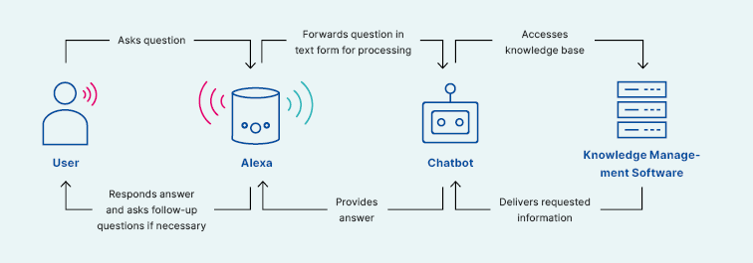For Silicon Valley experts, voicebots have long been the next major technology revolution after the cell phone. And many consumers in Germany can no longer imagine everyday life without them. Virtual assistants like Alexa, Siri, Bixby, Cortana & Co. are increasingly dominating our digital lives. Two out of five internet users now use digital voice assistants. This is the result of a representative survey commissioned by Bitkom and conducted in May 2020. "Intelligent voice assistants are developing rapidly and are available in more and more devices - from range hoods in the kitchen to cars," says Bitkom expert Dr. Sebastian Klöß. The following article also illustrates how voicebots will function as the customer service channel of the future and what possible applications there are, looking at German insurance company, the Versicherungskammer Bayern, as an example.
How voicebots work
How exactly do digital voice assistants work? When turned on, smart speakers run in standby mode and passively listen for the designated wake word such as “Alexa.” Once recognized, its voice control function is activated. The device then records the speech and forwards it to the manufacturer’s cloud platform. In the cloud, Natural Language Processing (NLP) converts the incoming audio into text for analysis using special algorithms. It is then forwarded to a server where the matching answer is found in text form. The result is then converted back into audio and output via the speaker. The entire process takes mere seconds.
Voice Commands with Skills
Aside from its natural language processing, the core of voice assistants are so-called “Skills” for Alexa or “Actions” for Google. These are built-in capabilities or apps created for a narrow purpose such as:
- Asking about the weather (“OK Google, what’s the weather today?”)
- Playing audio or video (“Alexa, play Everything is Awesome from the Lego movie!”)
- Controlling smart home devices (“OK Google, turn on the lights.”)
- Making purchases (“Alexa, buy more dog food.”)
These are applications that extend the existing range of functions of the speech recognition software. While every assistant comes with a wide range of existing capabilities from the manufacturer, each platform is open to developers enabling individuals and companies to create their own applications. The more skills or actions that are installed on a digital language assistant, the better it can respond to user commands and questions.
Intelligent use of voice assistance
In the future, voice assistance will be able to provide meaningful support for customer communication in numerous industries.
Automotive
When choosing a new car, a customer wants to know the cost of a special paint job in a specific color. By storing information on paint types and costs in the digital voice assistant’s database, it can easily provide the customer with instant information on the actual cost of that and other custom options.
Versicherungen
What exactly does the customer’s current policy cover? How much is the deductible? Questions such as these can be answered quickly and accurately using voice commands thanks to the smart voice assistant.
Healthcare
A customer is planning a trip abroad and has questions about which vaccinations are required. A virtual assistant can instantly answer the question with a list of required shots as well as suggest a local doctor to visit.
Financial services
A prospective customer is considering opening a new bank account. But first they want to know whether there are any monthly fees and what the interest rate is. Using a voice assistant, they receive answers to these questions in real time, enabling the customer to make a decision faster.
Deploying Voicebots in Customer Service
As digital voice assistances become a standard part of daily life, how soon will companies begin deploying them in customer service?
There are many promising scenarios for introducing digital assistants as a customer service channel, which vary from industry to industry. That‘s why it‘s important for companies to consider exactly what they want to offer, and which level of detail and personal information will be required. However, as with other customer service channels, it is important not to sacrifice quality for speed and to understand that the priority is adding value from the customer’s perspective, not just presence in a new channel! Moreover, setting up voice-based service requires a different level of effort and preparation than text-based options like publishing a simple FAQ.
Customer Use Case – Travel Insurance via Alexa
In cooperation with a German insurance company, the Versicherungskammer Bayern (Bavarian Insurance Chamber), USU has combined its leading knowledge management platform with Amazon’s Alexa. Using a specially developed skill, Alexa employs USU’s Knowledge Bot to answer customer questions about insurance services by accessing content in the company’s knowledge base. The answer is then read out by Alexa.
Existing and prospective customers can for example, ask Alexa about travel insurance and health coverage while abroad. Perhaps you’re at the airport and realize you never checked whether your current health insurance covers you on vacation. Simply fire up Alexa on your mobile phone and ask while waiting at the gate.
With Alexa connected to the insurance provider’s knowledge base, it always has access to the latest answers and policies instead of relying on static files or preprogrammed responses. Combining Knowledge Bot with Alexa enables true interactive dialogue with the customer and a dynamic back and forth based on the user’s questions versus cycling through a list of canned responses. Moreover, the integrated artificial intelligence ensures that both Alexa and the Knowledge Bot continuously learn and adapt to user questions for ongoing automatic optimization.

Fig: Functionality using the example of Amazons Alexa
Bonus: Any changes or additions to the information are made directly in Knowledge Center, without requiring developers to update the Alexa skill and release it again via Amazon!


